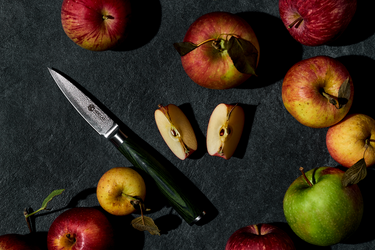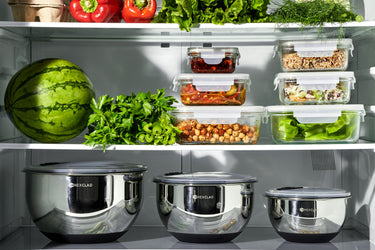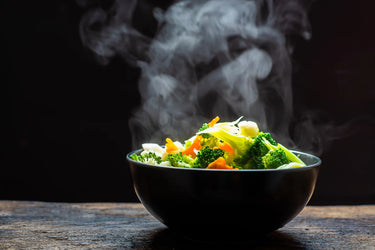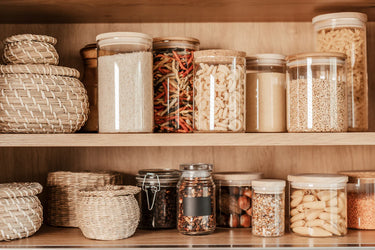Fresh Picks: Apples 101

Welcome to "Fresh Picks," in which we celebrate the seasonal produce we're obsessing over Right Now. Now that it’s autumn, it’s time for everyone’s favourite fall fruit: apples.
So you got carried away in the u-pick orchard and now you find yourself with a counter full of Honeycrisps and no plan. We're here for you.
As Canada’s most popular fruit, apples are many things to many people. An apple can be the go-to fruit for a packed lunch, the main ingredient in the world’s most iconic pie or squeezed to make juice, cider or brandy.
Apples figure heavily in mythology because they are one of the oldest cultivated crops. They were first propagated from wild crabapples in ancient times, and considered a luxury treat—more so than even figs!—by the Romans. More recently, European immigrants brought apple seeds with them to the United States, where they mixed with native crabapples to become a remarkably diverse and beloved category of American fruit.
There are about 8,000 varieties of apples worldwide, and thanks to a global marketplace and because the fruit can be stored for months, you can find them year-round.
Apples are also the definitive fall fruit: They’re harvested between August and November, when you’ll find the most variety and the freshest, crispest, most intensely flavourful fruit. (Their flavour mellows over time as they consume some of their own malic acid.) So brush up on your apple facts and get into the pumpkin-spice spirit with some creative recipes.
How to Select Apples
Apples differ in flavour—on a spectrum of very tart to very sweet—and in texture, from soft to crisp. Everyone has their own preferences for eating, but generally, if you want a baking apple, choose one that is sturdy enough to hold its shape and deliver some zing, like a Granny Smith. Some apples, such as Honeycrisp and Braeburn, are both crisp and sweet-tart, making them great for both eating and baking.
No matter what kind of apple you’d like, start by selecting fruit that’s heavy for its size, mildly fragrant, firm and unblemished without soft spots or nicks in the skin. Sometimes a vibrantly coloured apple is a good sign, but this isn’t a beauty contest; we all know the tragedy of a picture-perfect Red Delicious that tastes like nothing.
Some quirks are completely normal: Don’t worry about those rough tan patches that look a little like potato skin. That’s a phenomenon called russeting, and it doesn’t affect taste or texture. In fact, some people believe that apples with russeting are extra-sweet.
On yellow or lighter coloured apples, you might also see some tiny dots, called lenticels. These are essentially apple pores, allowing exchange of oxygen and carbon dioxide. (Yes, apples breathe, too!)

How To Store Apples
So about that giant orchard haul: Will you be forced to make 10 gallons of applesauce, a thing few folks but babies would appreciate? No need to do anything drastic: Apples keep well for weeks, even months, with some care.
You know what they say about one bad apple? Well, it’s true–one bad apple can spoil the bunch. So first, check your apples again for any soft spots, blemishes or mould and separate those out to eat right away.
After that, the only secret to apple storage is to keep the fruit cool and dry. The counter is fine for a week or two, but if you plan to keep apples longer than that, put them in the crisper drawer of your fridge. Just be sure to keep other fruits and vegetables away from them, because apples release a gas that can cause other produce to ripen or spoil too quickly. In the fridge, apples keep well for a month or two.
Ways to Cook With Apples
Apples are iconic in baked goods, but their true beauty lies in their versatility: They’re great in both sweet and savoury dishes, they’re lush when cooked, and they add crunch and zip when used raw—say, in a quick apple-jalapeño relish for pork chops. Their natural pectin means they are a lovely addition to sauces, like a simmered compote for pancakes or a vinegary pan sauce for roast chicken.
Grab your best paring knife and let’s cook some apples.
1. Apple and Bacon Pancakes
These sweet and savoury skillet pancakes are what breakfast-for-dinner dreams are made of. A simple batter is studded with crisp bacon and apple slices; the recipe suggests sweet-crisp Honeycrisps or Jonagolds. Top with Dutch apple syrup if you can find it, but maple syrup or a generous dollop of apple butter would gild the lily just as well.

2. German Potato Pancakes with Apple Compote
This recipe makes an elegant meal out of the classic potato pancake-applesauce combo, using a traditional German method for potato pancakes. You can also think of the dead-simple apple compote (just apples, sugar and water in a pot!) as a stand-alone recipe that you can dollop on pound cake or on pork chops (just add a pinch of salt). Apples naturally break down and thicken when simmered thanks to their natural pectin, so keep this easy trick in your back pocket.
3. Brown Butter Apple Pie
If there's one thing better than an all-butter crust, it's an all-brown-butter crust. This gorgeous apple pie from recipe developer Anna Stockwell features a mix of Granny Smiths and Galas, and a dreamy apple caramel comes replete with a dollop of vanilla bean paste, giving it a wonderful depth and texture.
Thanks to these tips and tricks, we pronounce you ready to celebrate the most wonderful time of the year: apple season.




